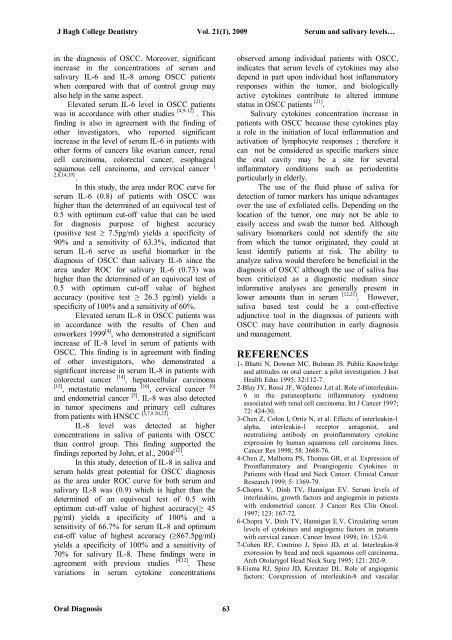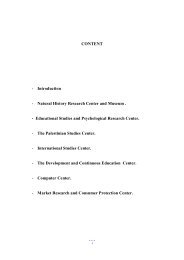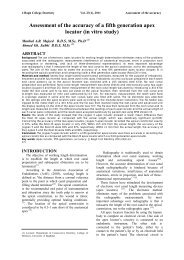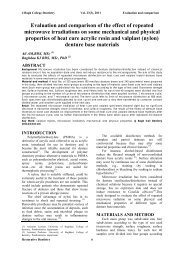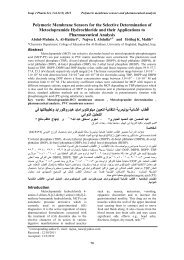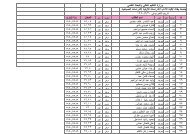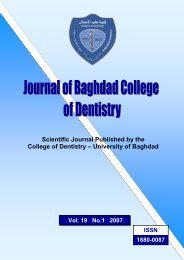Vol 21 No. 1
Vol 21 No. 1
Vol 21 No. 1
You also want an ePaper? Increase the reach of your titles
YUMPU automatically turns print PDFs into web optimized ePapers that Google loves.
J Bagh College Dentistry <strong>Vol</strong>. <strong>21</strong>(1), 2009 Serum and salivary levels…<br />
in the diagnosis of OSCC. Moreover, significant<br />
increase in the concentrations of serum and<br />
salivary IL-6 and IL-8 among OSCC patients<br />
when compared with that of control group may<br />
also help in the same aspect.<br />
Elevated serum IL-6 level in OSCC patients<br />
was in accordance with other studies [4,9-12] . This<br />
finding is also in agreement with the finding of<br />
other investigators, who reported significant<br />
increase in the level of serum IL-6 in patients with<br />
other forms of cancers like ovarian cancer, renal<br />
cell carcinoma, colorectal cancer, esophageal<br />
squamous cell carcinoma, and cervical cancer [<br />
2,6,14,19]<br />
.<br />
In this study, the area under ROC curve for<br />
serum IL-6 (0.8) of patients with OSCC was<br />
higher than the determined of an equivocal test of<br />
0.5 with optimum cut-off value that can be used<br />
for diagnosis purpose of highest accuracy<br />
(positive test ≥ 7.5pg/ml) yields a specificity of<br />
90% and a sensitivity of 63.3%, indicated that<br />
serum IL-6 serve as useful biomarker in the<br />
diagnosis of OSCC than salivary IL-6 since the<br />
area under ROC for salivary IL-6 (0.73) was<br />
higher than the determined of an equivocal test of<br />
0.5 with optimum cut-off value of highest<br />
accuracy (positive test ≥ 26.3 pg/ml) yields a<br />
specificity of 100% and a sensitivity of 60%.<br />
Elevated serum IL-8 in OSCC patients was<br />
in accordance with the results of Chen and<br />
coworkers 1999 [4] , who demonstrated a significant<br />
increase of IL-8 level in serum of patients with<br />
OSCC. This finding is in agreement with finding<br />
of other investigators, who demonstrated a<br />
significant increase in serum IL-8 in patients with<br />
colorectal cancer [14] , hepatocellular carcinoma<br />
[15] , metastatic melanoma [16] , cervical cancer [6]<br />
and endometrial cancer [5] . IL-8 was also detected<br />
in tumor specimens and primary cell cultures<br />
from patients with HNSCC [3,7,8 20,22] .<br />
IL-8 level was detected at higher<br />
concentrations in saliva of patients with OSCC<br />
than control group. This finding supported the<br />
findings reported by John, et al., 2004 [12] .<br />
In this study, detection of IL-8 in saliva and<br />
serum holds great potential for OSCC diagnosis<br />
as the area under ROC curve for both serum and<br />
salivary IL-8 was (0.9) which is higher than the<br />
determined of an equivocal test of 0.5 with<br />
optimum cut-off value of highest accuracy(≥ 45<br />
pg/ml) yields a specificity of 100% and a<br />
sensitivity of 66.7% for serum IL-8 and optimum<br />
cut-off value of highest accuracy (≥867.5pg/ml)<br />
yields a specificity of 100% and a sensitivity of<br />
70% for salivary IL-8. These findings were in<br />
agreement with previous studies<br />
[4,12] . These<br />
variations in serum cytokine concentrations<br />
observed among individual patients with OSCC,<br />
indicates that serum levels of cytokines may also<br />
depend in part upon individual host inflammatory<br />
responses within the tumor, and biologically<br />
active cytokines contribute to altered immune<br />
status in OSCC patients [<strong>21</strong>] .<br />
Salivary cytokines concentration increase in<br />
patients with OSCC because these cytokines play<br />
a role in the initiation of local inflammation and<br />
activation of lymphocyte responses ; therefore it<br />
can not be considered as specific markers since<br />
the oral cavity may be a site for several<br />
inflammatory conditions such as periodentitis<br />
particularly in elderly.<br />
The use of the fluid phase of saliva for<br />
detection of tumor markers has unique advantages<br />
over the use of exfoliated cells. Depending on the<br />
location of the tumor, one may not be able to<br />
easily access and swab the tumor bed. Although<br />
salivary biomarkers could not identify the site<br />
from which the tumor originated, they could at<br />
least identify patients at risk. The ability to<br />
analyze saliva would therefore be beneficial in the<br />
diagnosis of OSCC although the use of saliva has<br />
been criticized as a diagnostic medium since<br />
informative analyses are generally present in<br />
lower amounts than in serum [12,<strong>21</strong>] . However,<br />
saliva based test could be a cost-effective<br />
adjunctive tool in the diagnosis of patients with<br />
OSCC may have contribution in early diagnosis<br />
and management.<br />
REFERENCES<br />
1- Bhatti N, Downer MC, Bulman JS. Public Knowledge<br />
and attitudes on oral cancer: a pilot investigation. J Inst<br />
Health Educ 1995; 32:112-7.<br />
2-Blay JY, Rossi JF, Wijdenes J,et al. Role of interleukin-<br />
6 in the paraneoplastic inflammatory syndrome<br />
associated with renal cell carcinoma. Int J Cancer 1997;<br />
72: 424-30.<br />
3-Chen Z, Colon I, Ortiz N, et al. Effects of interleukin-1<br />
alpha, interleukin-1 receptor antagonist, and<br />
neutralizing antibody on proinflammatory cytokine<br />
expression by human squamous cell carcinoma lines.<br />
Cancer Res 1998; 58: 3668-76.<br />
4-Chen Z, Malhotra PS, Thomas GR, et al. Expression of<br />
Proinflammatory and Proangiogenic Cytokines in<br />
Patients with Head and Neck Cancer. Clinical Cancer<br />
Research 1999; 5: 1369-79.<br />
5-Chopra V, Dinh TV, Hannigan EV. Serum levels of<br />
interleukins, growth factors and angiogenin in patients<br />
with endometrial cancer. J Cancer Res Clin Oncol.<br />
1997; 123: 167-72.<br />
6-Chopra V, Dinh TV, Hannigan E.V. Circulating serum<br />
levels of cytokines and angiogenic factors in patients<br />
with cervical cancer. Cancer Invest 1998; 16: 152-9.<br />
7-Cohen RF, Contrino J, Spiro JD, et al. Interleukin-8<br />
exoression by head and neck squamous cell carcinoma.<br />
Arch Otolarygol Head Neck Surg 1995; 1<strong>21</strong>: 202-9.<br />
8-Eisma RJ, Spiro JD, Kreutzer DL. Role of angiogenic<br />
factors: Coexpression of interleukin-8 and vascular<br />
Oral Diagnosis 63


